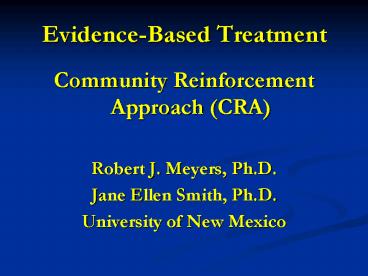EvidenceBased Treatment PowerPoint PPT Presentation
1 / 33
Title: EvidenceBased Treatment
1
Evidence-Based Treatment
- Community Reinforcement Approach (CRA)
- Robert J. Meyers, Ph.D.
- Jane Ellen Smith, Ph.D.
- University of New Mexico
2
Early CRA Studies
- Hunt Azrin, 1973
- Azrin, 1976
- Azrin, Sisson, Meyers, Godley, 1982
3
Hunt Azrin 1973
- inpatient alcoholics
- job finding counseling
- behavioral/marital tx
- social/leisure counseling
- reinforcer access counseling
- social club
- home visits
- total 50 hrs per client
4
Results 6 month follow-up
5
Azrin 1976 New Improved CRA
- inpatient alcoholics
- disulfiram w/compliance protocol
- problem prevention rehearsal
- buddy system
- early warning mood monitoring
- some group tx
- 70 as aftercare home visits
- Average 30 contact hrs
6
CRA new improved Results
7
1st CRA Outpatient Study (Azrin, Sisson, Meyers,
Godley, 1982)
- 43 outpatient alcoholics
- 3 groups
- traditional tx only
- traditional tx disulfiram compliance
- CRA only
- increased use of positive reinforcement
- sobriety sampling
- immed. disulfiram
- drink refusal training
- /- functional analysis
- job club
- phone contacts
- Average 5 tx sessions
8
Results of 1982 study
- 6 month follow-up
- Disulfiram only group days abs 74
- CRA days abs 97
- Traditional group day abs 45
9
CRA with Homeless Alcohol-Dependent Individuals
- PI Jane Ellen Smith
- Co-PI Robert J. Meyers
- Funded by NIAAA
10
Primary Questions Addressed
- Is CRA gt a day shelters standard program for
treating drinking problems among homeless
individuals? - What are the effects of the 2 treatments on the
non-drinking variables (employment, housing)?
11
CRA Group
- Group Sessions
- Problem-Solving
- Communication Skills
- Drink-Refusal
- Independent Living Skills
- Goal Setting/Community Meeting
- Social Club
- Disulfiram Compliance
- Individual Sessions
- Job Finding
- Case Management
- Couples Therapy
12
Standard Treatment Group
- Day Shelter Program
- Project Share
- Alcoholics Anonymous Meetings
- 12-Step Counselor
- Job Service Program
- VA Benefits Advisor
- Project CARE
13
Grant-Provided Housing
- All participants were housed
- Normal stay 3 months
- Extended stays if job and saved
- Random breathalyzer tests
14
Drinks Per Week By Condition
--- Standard --- CRA
Median SECs
2 Month 4 Mont 6
Month 9 Month 12
Month
Follow-Up Period
15
Percent Homeless By Condition
CRA Standard
Percent
2 Month 4 Month 6 Month
9 Month 12 Month
Follow-up Periods
16
Percent Employed By Condition
CRA Standard
Percent
Intake 2 Month 4 Month 6
Month 9 Month 12 Month
Follow-up Period
17
Limitations of the Study
- Not comparable doses of treatment
- Some CRA participants still drinking heavily
- Only moderate improvement in employment
- Cost of housing
18
CRA with Homeless Alcoholic Women
- Why women only?
- Treatments
- Case Management
- CRA
- CRA contingency-managed computer training
19
Summaries of Adult Treatment Research for Alcohol
Use Disorders
- Meta-analyses and Reviews
20
Evidence of Effectiveness Meta-analyses
- Holder et al., 91 Miller et al., 95
- Social skills training Brief intervention
- Self-control training Social skills training
- Brief motivational tx MET
- Behavioral Marital tx CRA
- CRA Behavioral contract
- Stress management Aversion tx
21
Evidence of Effectiveness (contd)
- Finney et al., 96 Miller et al., 03
- CRA Brief Intervention
- Social skills training Motivational Enhancement
- Behavioral Marital tx Acamprosate
- Disulfiram Implants CRA
- Other marital tx Self-Change (bibliotherapy)
- Stress Management Naltrexone
22
CRA for Illicit Drugs Adult Studies
- Cocaine
- Higgins et al. (1991 1993 1994 1995 2000)
- Heroin
- Bickel et al. (1997)
- Abbott et al. (1998)
23
Adolescent CRA
24
Godley et al. (2002)
- Continuing care study (after residential
treatment) - UCC (usual continuing care) or ACRA case mgmt
- 114 adolescents
- 90 marijuana dependent at intake
- 57 alcohol dependent
- 82 involved w/ juvenile justice system
25
Results 3 months
- ACRA significantly gt UCC in terms of
- abstinence from marijuana
- reduced alcohol use
26
Cannabis Youth Treatment (CYT) Study (Dennis et
al., 2004)
- Outpatient treatment for marijuana
- Trial 1MET/CBT5 MET/CBT12 FSN
- Trial 2 MET/CBT5 ACRA MDFT
- 600 adolescents
- Hi rate of illegal activities
27
Results 12 months
- Measures
- (1) days of abstinence (from drugs alcohol)
- (2) in recovery living in community (not
jail) - no use no past month substance problems
- General Findings All treatments significantly
improved pre-post no significant tx comparison
differences
28
- Best overall in recovery rates ACRA (34
next best MET/CBT5 at 27) - Best of abstinent days for Trial 2 ACRA (73
of days during the year best for Trial 1
MET/CBT5 at 74) - Most cost-effective? ACRA
29
UNM CASAAs Street Youth Program Project STAR
30
Percent days of substance use
Significant interaction between time (pre to 6
months) and group using number of treatment
sessions as covariate (F (1, 81) 9.10, p lt .01).
31
Percentage of days off the street
Trend toward interaction between time (pre to 6
months) and group using number of treatment
sessions as covariate (F (1, 81) 3.09, p . 08).
32
What does not work!
- Educational films and lectures
- General alcoholism counseling
- Psychotherapy
- Confrontational counseling
- Antipsychotic medication
- Psychotherapy, group process
- Insight therapy
33
Why Isnt CRA Used More?
- Disease Model
- Limited accessibility
- Its hard to teach an old dog new tricks
- We already do that
- CRA isnt sexy

